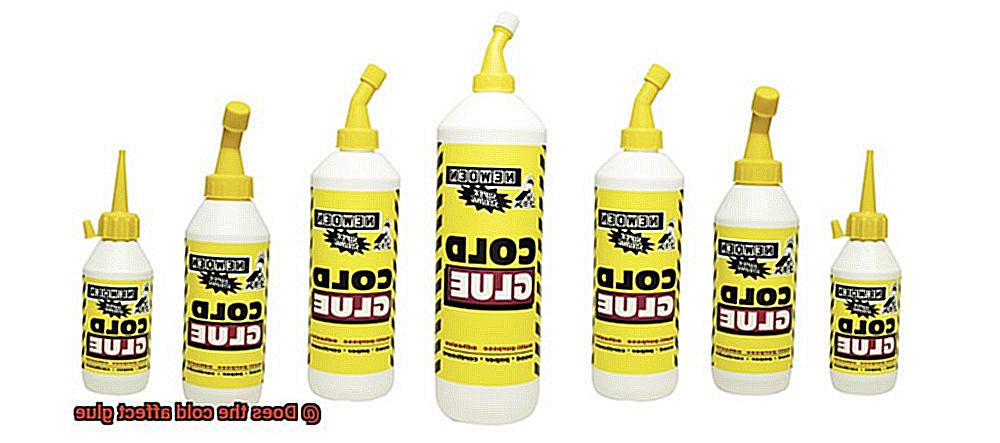Glue, the unsung hero of the crafting and DIY world, has a knack for holding things together. Whether you’re fixing a busted chair or creating a masterpiece from scratch, glue is your trusty companion. But here’s the twist: ever wondered how this sticky substance fares in the face of icy cold temperatures?
From frosty winters to frigid air-conditioned rooms, it turns out that the cold can throw a wrench into glue’s adhesive powers. In this blog post, we’ll dive deep into the fascinating relationship between temperature and glue, uncovering why these two elements are intertwined like inseparable soulmates.
Understanding how glue behaves in colder conditions is crucial for ensuring your projects stand strong and last long. By grasping how chilly environments affect different types of glue, you can fine-tune your crafting endeavors and sidestep any potential letdowns.
So buckle up for this adhesive adventure as we explore just how much of an impact the cold can have on our beloved sticky companion and discover strategies to keep it sticking strong.
Types of Glue and Their Optimal Temperature Range
Contents
- 1 Types of Glue and Their Optimal Temperature Range
- 2 How Cold Temperatures Impact Glue Viscosity
- 3 The Effects of Cold on Bonding Strength
- 4 Risk of Freezing in Extreme Cold Conditions
- 5 Proper Storage to Maintain Glue Integrity
- 6 Warming Up Glue Before Use
- 7 Longer Curing Times in Cold Temperatures
- 8 Mitigating the Effects of Cold on Glue Performance
- 9 Conclusion
Glue is a fascinating substance that allows us to create strong bonds between various materials. However, not all glues are created equal, and understanding their optimal temperature range is crucial for achieving the best results. In this article, we will delve into the world of glue and explore how different types of glue perform under varying temperature conditions.
Super Glue – The Swift Fixer:
Super glue, also known as cyanoacrylate adhesive, is the hero of quick bonding. However, it has a dislike for extreme cold temperatures. When the mercury drops, super glue takes its sweet time to dry, leaving you impatiently waiting for your fix. Nobody enjoys waiting, especially when it comes to fixing something urgently.
Epoxy Glue – The Mighty Strength:
Epoxy glue flexes its muscles when it comes to heavy-duty projects. It loves showcasing its strength but doesn’t fare well in extreme cold or hot temperatures. In freezing conditions, epoxy becomes sluggish, taking longer to cure. On scorching hot days, it might not achieve its full bonding potential. Epoxy glue demands a Goldilocks temperature range – not too hot, not too cold, but just right.
Wood Glue – The Lumber Lover:
Wood glue is tailor-made for woodworking projects. It thrives in cozy temperatures above 55°F (13°C). When the temperature drops below this threshold, wood glue loses some of its magic, leaving your wooden creations feeling a bit wobbly. To ensure sturdy and reliable bonds in woodworking, make sure the temperature is just right for wood glue to work its wonders.
Hot Glue – The Crafty Companion:
Hot glue is a crafter’s best friend, acting as liquid sunshine that melts into a molten state using a hot glue gun. It is a versatile glue that can tolerate both hot and cold temperatures. However, beware of extreme cold. When Jack Frost pays a visit, hot glue can become brittle and lose its adhesive powers. Keep your crafty creations out of the freezing cold to ensure their longevity.
Craft Glue – The Creative Chameleon:
Craft glue, also known as white glue or PVA glue, is the go-to adhesive for all your paper and craft projects. It thrives in the cozy room temperature range between 50°F and 85°F (10°C and 30°C).
However, when winter arrives with its chilly winds, craft glue may lose its stickiness, making it harder to create your paper masterpieces. Keep your craft room warm and toasty to maintain the perfect bond with craft glue.

How Cold Temperatures Impact Glue Viscosity
Viscosity, the measure of a liquid’s thickness or flowability, is the key player in this chilly tale. When exposed to cold temperatures, the molecules within glue slow down and lose their mobility, causing the glue to thicken and become less willing to flow.
But hold on. Not all glues respond in the same way to cold temperatures. Take cyanoacrylate glues, also known as super glues, for instance. These trusty adhesives can turn extremely brittle in the cold, making them more likely to crack or break under pressure. On the flip side, certain epoxy-based glues thrive in colder conditions. They cure faster and create stronger bonds that can withstand the icy grip of winter.
But that’s not all. In extreme cold, some glues can freeze solid, rendering them utterly useless until they thaw out. Picture a frozen blob of glue – not exactly the ideal scenario for your crafting needs.
To avoid these sticky situations (pun intended), it’s crucial to store your glues in temperature-controlled environments. Consistent temperatures will maintain optimal viscosity and ensure peak performance. And don’t forget to let your glue warm up to room temperature before application; this little trick will enhance its flowability.
Here’s a pro tip: save your gluing endeavors for warmer days. Low temperatures hinder the curing process and weaken bond strength. The last thing you want is a feeble bond that crumbles under even the slightest pressure.
To sum it up, cold temperatures undeniably impact glue viscosity. Glue thickens and becomes more challenging to work with in frigid weather. But fear not. By understanding how different glues react to cold temperatures and taking simple precautions, you’ll conquer any gluing challenge that comes your way.
The Effects of Cold on Bonding Strength
Surprisingly, cold temperatures and adhesive bonds are more intertwined than one might think. In this blog post, we’ll explore the captivating world of glue and delve into how frigid temperatures can put a freeze on bonding strength. So grab a warm drink and let’s embark on this fascinating journey.
The Science Behind It:
When the mercury drops, glue molecules start to feel the chill. Like hibernating bears, these molecules slow down and become less active. And just as your productivity may plummet during the colder months, so does the bonding strength of glue. The reduced molecular activity hampers the formation of strong intermolecular bonds between the surfaces it aims to bind.
But that’s not all – cold temperatures also render glue more brittle and rigid. Picture trying to bend a frozen tree branch; it would likely snap under pressure. Similarly, glue becomes more prone to cracking or breaking under stress when subjected to extreme cold.

The Glue Lineup:
Not all glues are created equal when it comes to cold weather resilience. Certain epoxy or cyanoacrylate adhesives (aka super glues) are built tough and can retain their bonding strength better than others in frosty conditions. These glues are akin to winter warriors in the adhesive world – they scoff at freezing temperatures.
On the flip side, some glues freeze solid when confronted with extreme cold. Imagine an unyielding glob of adhesive that refuses to budge until it thaws out – not an ideal scenario for your crafting endeavors.
Tips and Tricks:
So how can you ensure your adhesive bonds don’t crumble in the cold? Here are a few helpful tips:
- Check temperature limitations: Some glues have specific temperature ranges recommended by the manufacturer. Staying within these limits ensures optimal bonding strength.
- Preheat and prime: Before applying glue in cold environments, consider preheating the surfaces or using a heat gun. The added warmth activates the adhesive properties of the glue, enhancing its ability to form robust bonds.
- Specialized glues for cold weather: If you anticipate working in freezing temperatures, opt for a glue specifically formulated for cold weather applications. These specialized glues are designed to remain effective and maintain their bonding strength even in icy conditions.
Risk of Freezing in Extreme Cold Conditions
Today, we dive into the chilling world of freezing glue and uncover the risks it poses in extreme cold conditions. So grab a hot beverage, cozy up, and let’s explore how to keep your adhesive bonds strong even in icy weather.
The Icy Perils of Freezing Glue:
When the mercury drops, glue faces some serious challenges. One major risk is the formation of ice crystals within the adhesive. Freezing can disrupt the molecular structure by freezing any moisture present in the glue, weakening its bonding ability. Thawing may not restore the bonds properly, leaving you with a less reliable adhesive.
Another danger lies in increased brittleness. As glue freezes, it undergoes a phase change from liquid to solid, rearranging its molecules and weakening its structure. This makes it more prone to cracking or breaking under stress or movement.

Separation or stratification of glue components is yet another risk. Freezing can cause these components to separate or settle, resulting in an inconsistent bond. Even after thawing, these separated components may not mix properly, leading to an uneven or weak bond.
But fear not. Here are some tips to minimize these risks and ensure your glue triumphs over winter’s icy grip:
Follow Manufacturer’s Instructions:
Different glues have varying degrees of tolerance to freezing temperatures. Always consult the manufacturer’s guidelines on storage and usage in extreme cold conditions.
Choose Winter Warriors:
Certain epoxy or cyanoacrylate adhesives are specifically designed to withstand freezing temperatures. These winter warriors maintain their strength even in bone-chilling cold.
Preheat Surfaces:
Consider preheating surfaces using a heat gun or hairdryer before applying glue. This eliminates residual moisture and ensures better bonding in colder environments.

Use Specialized Cold Weather Glues:
Opt for glues formulated for cold weather applications. These specialized adhesives have additives that enhance their performance in freezing conditions.
Store Properly:
Store glue in a controlled environment, ideally at room temperature. Avoid leaving it in your vehicle or any unheated space where extreme cold temperatures can wreak havoc on its effectiveness.
As the temperature drops, so does the bonding strength of glue. Freezing can lead to weakened bonds, increased brittleness, separation of components, and changes in viscosity. However, by following these tips and choosing the right glue for the job, you can ensure your adhesive bonds remain strong even in extreme cold conditions.
Proper Storage to Maintain Glue Integrity
Proper storage is an essential aspect of maintaining glue integrity, particularly when it comes to its resistance to cold temperatures. Glue can undergo chemical and physical changes when exposed to extreme cold, which can significantly impact its performance and effectiveness. To ensure that your glue remains reliable even in chilly conditions, here are some key storage practices to follow:
- Temperature Control: Glue should be stored in an environment with a stable temperature between 50°F and 77°F (10°C and 25°C). Extreme cold temperatures can cause the glue to thicken or freeze, rendering it unusable. On the other hand, high temperatures can degrade the adhesive properties of the glue. Finding that sweet spot in terms of temperature is crucial.
- Protect from Cold Air and Drafts: Store your glue in airtight containers or sealed bags to prevent direct exposure to cold air. When glue comes into contact with cold air, moisture from the air can condense on its surface, leading to water droplets. These droplets can interfere with the glue’s bonding ability and compromise its overall performance.
- Avoid Temperature Fluctuations: Keep your glue away from windows or areas that experience temperature fluctuations. Placing glue near a window during winter can expose it to colder temperatures when the window is open or when outside temperatures drop. These fluctuations can cause the glue to expand and contract, potentially resulting in cracks or changes in viscosity.
- Keep Containers Closed: Ensure that your glue container is tightly closed when not in use. This prevents moisture from entering the container and affecting the quality of your glue. Moisture can make the glue lumpy, cause separation, or even lead to a loss of adhesive properties.
- Check Expiration Dates: Always check the expiration dates of your glues and discard any that have passed their shelf life. Over time, glues can deteriorate due to exposure to air, moisture, or temperature variations. Using expired glue may result in weak bonds or adhesion failure.
Warming Up Glue Before Use
In this post, we’ll explore the reasons why warming up glue is crucial, different methods you can use, and some handy tips to ensure you get the best results. So, let’s dive into the world of warm glue and unlock its sticky potential.
Why Warm Up Glue?
Temperature Effects: Glue is composed of various chemicals, including polymers, solvents, and additives. These components are sensitive to temperature changes. Cold temperatures can cause the glue to become thicker and less flexible, diminishing its bonding strength and making it difficult to work with.
Methods of Warming:
- Warm Water Bath: One effective method is to place your glue container in a warm water bath. This gentle heating process allows the glue to gradually warm up without risking overheating or compromising its properties.
- Heat Gun or Hairdryer: If you’re working with smaller amounts or need more localized heating, a heat gun or hairdryer can be utilized. Begin with a low heat setting and maintain a safe distance to avoid overheating the glue.
Tips for Success:
- Avoid Excessive Heat: It’s crucial to exercise caution and not overheat the glue. Excessive heat can cause solvents to evaporate too quickly, resulting in unusable glue. Always follow the manufacturer’s instructions to prevent any mishaps.
- Glue Variability: Not all glues require warming before use. Some glues are specifically formulated to be more resistant to temperature changes and may not need additional warming. Check the label or manufacturer’s instructions for guidance.
Longer Curing Times in Cold Temperatures
Glue, the unsung hero of DIY projects and repairs, possesses a remarkable ability to bond materials together. However, even this mighty adhesive succumbs to the chilling touch of cold temperatures. In this blog post, we will embark on a journey to understand how cold temperatures impact glue curing time and explore effective solutions to ensure successful bonding, even in freezing conditions.
The Science Behind It:
- Temperature’s Crucial Role: Curing time is heavily influenced by temperature as it directly affects the chemical reaction during the curing process.
- Lack of Sufficient Heat: As temperatures drop, the heat required for the reaction decreases, leading to a slower curing process.
- c. Viscosity Variations: Cold temperatures cause glue to thicken, making it challenging to spread evenly and potentially resulting in weakened bonds.
Types of Glue and Their Cold Resistance:
- Cyanoacrylate Glues (Super Glue): These commonly used glues exhibit significantly slower curing times in colder temperatures.
- Epoxy Glues: While they also experience longer curing times in cold conditions, they remain relatively effective compared to other adhesive types.
Overcoming Cold Weather Challenges:
- Heat It Up: Utilize heat sources like hairdryers or heat guns to warm up the application area, accelerating the curing process by providing the necessary heat.
- Specialized Cold Weather Adhesives: Opt for adhesives specially formulated to cure effectively in low temperatures due to added additives that counteract cold-induced slow curing.
- Optimal Temperature Maintenance: Ensure both materials being bonded and the glue itself are stored at optimal temperatures before and during application to maintain effectiveness.
Extra Curing Time and Patience:
- Allow Additional Time: Exercise patience and allocate extra curing time when working with glue in colder temperatures to ensure a strong and durable bond.
- Alternative Bonding Methods: In extreme cold conditions, explore alternative bonding methods or consider using different types of adhesives that are better suited for low temperatures.
Mitigating the Effects of Cold on Glue Performance
Today, we dive into the fascinating world of glue and its nemesis: cold temperatures. We all know that glues can be powerful allies in our DIY projects or industrial endeavors. However, when faced with chilly conditions, even the mightiest glues can lose their strength.
In this blog post, we will explore the science behind this phenomenon and equip you with practical tips to mitigate the effects of cold on glue performance.
Choosing the Right Glue:
Not all glues are created equal when it comes to cold weather applications. Opt for glues specifically formulated to withstand low temperatures and maintain their adhesive properties.
Look for labels that mention cold weather resistance or low-temperature suitability. These specialized glues have additives that prevent them from becoming brittle or losing adhesion in freezing conditions.
Surface Preparation:
Properly preparing the surface is crucial in cold weather. Cold surfaces can hinder the bonding process, so ensure you clean and dry them thoroughly before applying the glue. Eliminating any dirt, moisture, or contaminants will enhance the bond strength.
Consider using a solvent or degreaser to remove any oils or residues that could compromise the adhesive properties of the glue.
Primers and Adhesion Promoters:
To further improve bond strength in freezing conditions, consider using a primer or adhesion promoter. These products act as a mediator between the glue and surface, enhancing adhesion even in cold temperatures. Primers create a chemical bond between the glue and surface, increasing its effectiveness in low temperatures.
Warm it Up:
When tackling cold-weather projects, give your glue a helping hand by applying it in a warm environment. Use heat sources like heat guns or heaters to gently warm up the area where you plan to apply the glue. This will counteract the effects of cold and ensure better adhesive performance. Be cautious not to overheat the surface, as this can affect the integrity of the material being bonded.
Curing Time Considerations:
Patience is key. In colder temperatures, glues may take longer to cure and reach their full strength. Allow sufficient curing time to ensure a strong bond that can withstand freezing conditions.
Check the manufacturer’s instructions for recommended curing times in low-temperature environments. Consider using clamps or other means of securing the glued materials during the curing process to prevent any movement or detachment.
Proper Storage:
To maintain the effectiveness of your glue in cold weather, ensure proper storage. Keep glues in a cool and dry place, avoiding extreme temperature variations that can degrade their quality over time. Extreme heat or cold can alter the chemical composition of the glue, affecting its adhesive properties. Close containers tightly after use to prevent moisture absorption, which could compromise its performance.
X2isDGvQiX4″ >
Conclusion
The conclusion of our investigation into the question “Does the cold affect glue” is clear: yes, the cold does indeed have an impact on glue.
When exposed to low temperatures, glue can become less effective and may even fail to bond properly. This is due to the fact that cold temperatures can cause the adhesive properties of glue to weaken or break down entirely.
As a result, it is crucial to consider temperature conditions when using glue for any project. Whether you’re working on a DIY craft or repairing something around the house, be sure to take into account the temperature and choose a suitable adhesive that can withstand colder climates.
By doing so, you can ensure that your glue bonds securely and remains intact even in chilly conditions.






